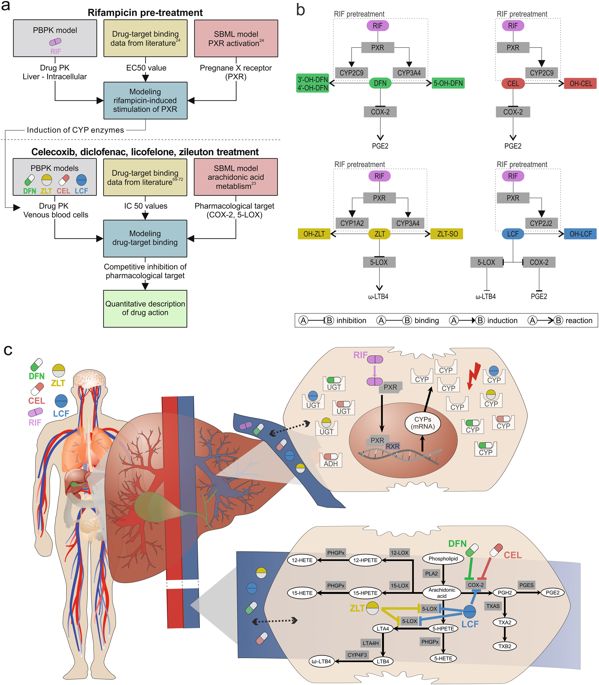npj Systems Biology and Applications ( IF 4 ) Pub Date : 2018-08-03 , DOI: 10.1038/s41540-018-0062-3 Christoph Thiel 1 , Ines Smit 2 , Vanessa Baier 1 , Henrik Cordes 1 , Brigida Fabry 1 , Lars Mathias Blank 1 , Lars Kuepfer 1

|
A quantitative analysis of dose–response relationships is essential in preclinical and clinical drug development in order to optimize drug efficacy and safety, respectively. However, there is a lack of quantitative understanding about the dynamics of pharmacological drug–target interactions in biological systems. In this study, a quantitative systems pharmacology (QSP) approach is applied to quantify the drug efficacy of cyclooxygenase-2 (COX-2) and 5-lipoxygenase (5-LOX) inhibitors by coupling physiologically based pharmacokinetic models, at the whole-body level, with affected biological networks, at the cellular scale. Both COX-2 and 5-LOX are key enzymes in the production of inflammatory mediators and are known targets in the design of anti-inflammatory drugs. Drug efficacy is here evaluated for single and appropriate co-treatment of diclofenac, celecoxib, zileuton, and licofelone by quantitatively studying the reduction of prostaglandins and leukotrienes. The impact of rifampicin pre-treatment on prostaglandin formation is also investigated by considering pharmacokinetic drug interactions with diclofenac and celecoxib, finally suggesting optimized dose levels to compensate for the reduced drug action. Furthermore, a strong correlation was found between pain relief observed in patients as well as celecoxib- and diclofenac-induced decrease in prostaglandins after 6 h. The findings presented reveal insights about drug-induced modulation of cellular networks in a whole-body context, thereby describing complex pharmacokinetic/pharmacodynamic behavior of COX-2 and 5-LOX inhibitors in therapeutic situations. The results demonstrate the clinical benefit of using QSP to predict drug efficacy and, hence, encourage its use in future drug discovery and development programs.
中文翻译:

使用定量系统药理学评估 COX-2 和 5-LOX 抑制剂在治疗情况下的药效
剂量反应关系的定量分析对于临床前和临床药物开发至关重要,以分别优化药物疗效和安全性。然而,对生物系统中药理学药物-靶点相互作用的动力学缺乏定量理解。在本研究中,采用定量系统药理学 (QSP) 方法,通过耦合基于生理学的药代动力学模型,在全身范围内量化环氧合酶 2 (COX-2) 和 5-脂氧合酶 (5-LOX) 抑制剂的药物功效。在细胞水平上,受影响的生物网络。COX-2 和 5-LOX 都是产生炎症介质的关键酶,也是抗炎药物设计中的已知靶点。这里通过定量研究前列腺素和白三烯的减少来评估双氯芬酸、塞来考昔、齐留通和利克非隆的单一和适当联合治疗的药物功效。通过考虑与双氯芬酸和塞来昔布的药代动力学药物相互作用,还研究了利福平预处理对前列腺素形成的影响,最终提出了优化的剂量水平以补偿药物作用的降低。此外,还发现患者观察到的疼痛缓解与 6 小时后塞来考昔和双氯芬酸引起的前列腺素减少之间存在很强的相关性。研究结果揭示了全身环境中药物诱导的细胞网络调节的见解,从而描述了 COX-2 和 5-LOX 抑制剂在治疗情况下的复杂药代动力学/药效学行为。结果证明了使用 QSP 预测药物疗效的临床益处,因此鼓励其在未来的药物发现和开发项目中使用。



























 京公网安备 11010802027423号
京公网安备 11010802027423号